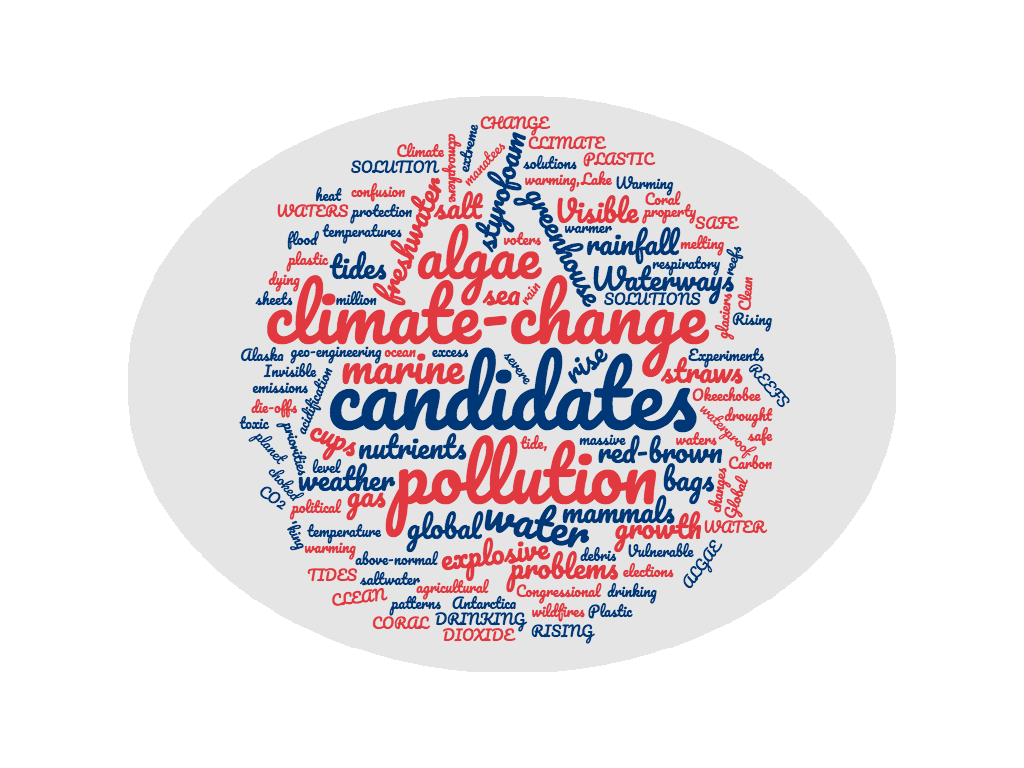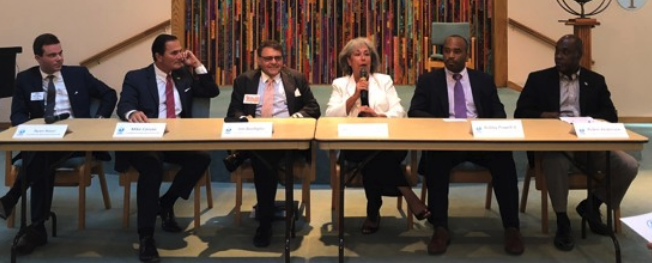Candidates Confuse Clean-Up, Carbon, Climate Change


With the upcoming elections, local and national, it is a good time to “clear the air” and end the confusion. For this purpose, my definition of “climate change” (or global warming) is:
The relatively sharp increase in Earth’s average temperature over decades, that can be distinguished from previous natural climate cycles, which closely correlates with the use of fossil fuels and significantly higher carbon dioxide levels. During this era, global average temperature is almost two degrees Fahrenheit warmer (one degree Celsius) and increasing.
Climate-related issues are extremely diverse and can be confusing. Consider:
- Warmer temperatures, which in addition to record number of high-heat days, directly cause worse wildfires, record rainfall, more severe drought, severe storms, faster melting ice sheets & glaciers, and rising sea level
- Carbon dioxide emissions (CO2) and other greenhouse gases
- Flooding from record rainfall, extreme high tides, rising sea level, and severe storms
- Plastic bags, straws, and other visible pollution
- Invisible pollution such as excess nutrients from agricultural runoff
- Explosive algae growth, both freshwater and saltwater
- Clean, safe drinking water
- Coral reefs in decline
- Beach erosion
- Habitat change and species extinction
All are important. Some are related, but some are not. Voters and candidates need to know which is which if we are to change policies and solve problems. Briefly, to clarify, with some comments about “solutions”
Clarifying 10 Different Issues and Solutions for Candidates and Voters

CARBON DIOXIDE (CO2) a major greenhouse gas (GHG), depicted by the blue line, has spiked dramatically during the industrial era, now in fact, at 410 PPM (parts per million), 40% higher than in millions of years. CO2 has fluctuated naturally from 180-280 PPM following the “ice age” cycles for millions of years.Though there is a lag time, temperature is climbing quite quickly, following the spike in CO2 levels. SOLUTIONS: We must reduce global CO2 emissions, or remove CO2 from the atmosphere. CO2 mixes globally in the atmosphere. Efforts to reduce the level of carbon dioxide must be done at a global scale. The most direct way to reduce CO2 emissions is to reduce energy consumption, or use non-fossil fuel based energy, such as solar, wind, hydro, ocean, or nuclear.
FLOODING is becoming more than a nuisance in coastal communities all over the world. Flooding can occur from heavy rainfall and runoff; coastal storm waves and storm surge; from extreme high tides and from rising sea level. Tide heights vary with the position of the moon and sun, following daily, lunar monthly and a 19-year cycle (lunar nodal cycle) but are precisely predictable to the minute and height at any given location. In recent years, the extreme high tides keep getting higher because there is more water in the oceans — rising sea level. This results primarily from the melting ice sheets and glaciers on land, primarily in places like Alaska, Greenland and Antarctica. SOLUTIONS: Some flooding can be addressed by better drainage, elevating structures, levees, temporary barriers, pumps, etc. To stop sea level from rising we have to stop the warming temperature, which is melting the ice. That brings us back to the CO2 problem described just above. But even the most aggressive efforts to reduce CO2 levels cannot quickly stop the melting ice and the rising sea, due to the excess heat already stored in the sea. Several feet of higher sea level are already unstoppable. Thus the other solution is to begin adapting to higher sea level and worse coastal flooding. This requires designing with higher elevation, with waterproof flood protection; building on floats, or build on higher ground. We need innovations in architectural design, engineering, revisions to building codes, etc.
PLASTIC bags, straws, styrofoam cups, and packaging is disgusting and a hazard to animal life. Surprisingly, despite the fact that plastics are made from petroleum, they have almost no relevance to slowing global warming. In other words, if all plastics were eliminated, the rate of temperature increase would not change noticeably. SOLUTIONS: Removal from the environment, and reducing or eliminating the use of plastics by improved regulation and enforcement.
INVISIBLE POLLUTION such as excess nutrients from agricultural runoff. Examples include the high levels of nutrient from farm fertilizers or animal waste. In rural areas particularly, antiquated septic systems can also contribute. All of these spur the growth of harmful bacteria and algae – see next item. A notable example is the Everglades in Florida where the effluent from vast agriculture including the sugar industry introduces huge nutrient content. SOLUTIONS: Regulations, processing of waste, retention ponds, etc.
Explosive growth of ALGAE. In addition to the visible pollution and debris such as plastic cited above, in many areas like Florida there has been recent dramatic growth of freshwater and saltwater algae. Freshwater algae, usually green, can clog, lakes, and canals. Effects now include shutting down power plants because the cooling systems do not function properly, both due to the vegetation as well as the warmer water. Saltwater algae, usually red-brown, has a particularly noxious variety, known as “red tide” that can cause massive massive die-offs of fish, mammals and waterfowl. Though there are several species, the key element is a nerve agent, a natural brevetoxin. In high enough concentrations it has a severe odor and can cause respiratory problems for people. The noxious red tide has even affected property values. In general the proliferation of algae is associated with warmer water temperature and higher nutrient levels. SOLUTIONS to global warming and excess nutrients are covered above.
CLEAN, SAFE DRINKING WATER is a concern in communities all over the world. Problems range from contamination from septic and wastewater systems; diseases; hazardous wastes, and salt water intrusion (as sea level rises). Supply shortages can also be due to population growth and climate change. SOLUTIONS: Better regulation, laws and enforcement, Improved infrastructure for water treatment and distribution can address the problems of quality. The problem of supply shortages may be addressed by conservation, desalination, and recovering water through advanced treatment.
CORAL REEFS are dying globally. About 10% are now dead and an estimated 50% will be dead by 2030. Die offs have occurred several times in their 500 million year history.Most of the reefs today are about 10,000 years old. Today, coral mining, agricultural and urban runoff, pollution (organic and inorganic), overfishing, blast fishing, disease, and the digging of canals and access into islands and bays are localized threats to coral ecosystems. Broader threats are sea temperature rise, sea level rise and pH changes from ocean acidification, all associated with greenhouse gas emissions. SOLUTIONS: Many of the threats identified can be reduced through education, regulation and enforcement. For the warming, experiments to find temperature resistant coral species are scientifically interesting but do not as yet offer a realistic reversal of the larger trend.
BEACH EROSION is a growing problem in coastal communities worldwide. Hundreds of millions of dollars are now spent each year to restore beaches. The cost will no doubt escalate in the coming years. While rising sea level will likely make the problem somewhat worse, beach erosion is a natural process that would occur without climate change. It should be viewed as somewhat of a separate issue. (For further explanation, see my blog post Beach Erosion or Rising Sea Level) SOLUTIONS: Beach restoration may be desirable in the short term, but most seawalls and other “hardening” often make the problems worse in the longer term. We need to recognize that beaches will always migrate. Setbacks and landscape designs should acknowledge that reality.
HABITAT CHANGE AND SPECIES EXTINCTION With warming temperatures, suitable habitats are changing. Some species can migrate to colder areas, but others have no option. The polar bear is an iconic example of a special species that may eventually be threatened. There are hundreds, or even thousands of others. SOLUTIONS: Ultimately we need to halt the rise in temperature. Conservation policies may also help, as well as relocating animals to suitable new climates.
In conclusion, it is great that some political candidates are making “environmental” issues a priority, especially those addressing climate change. It is essential however, that the problems, priorities, and solutions be real and connected. When I read the Palm Beach Post article it was clear that some candidates are on target while others were confused. Candidates and voters need to be well informed.
As you go to the polls, please consider voting for those candidates who clearly state their concern for climate change. I believe it is the #1 issue and will determine the quality of life for future generations, and potentially whether our species survives. If there are competing candidates who express such concern, explore further to find the one that understands the distinctions described above. If they are misinformed, educate them!
